![]()
![]()
![]()
Use LEFT and RIGHT arrow keys to navigate between flashcards;
Use UP and DOWN arrow keys to flip the card;
H to show hint;
A reads text to speech;
19 Cards in this Set
- Front
- Back
- 3rd side (hint)
|
Phenomena that support wave nature of light |
Interference, superposition, diffraction, polarisation |
|
|
|
Phenomena that support particle nature of light |
Photoelectric effect, Compton effect |
|
|
|
Who suggested that light had dual nature |
De broglie |
|
|
|
What could rectilinear propagation of light NOT explain |
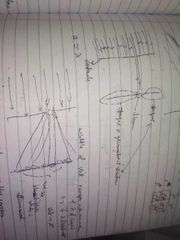
Couldn't explain why light(when allowed to pass through slit whose wavelength was in the range of that of light) tended to spread into the regions of otherwise geometrical shadows. |
|
|
|
Definition of wavefront |
Huygen was the one who said that light travels in the form of wavefronts. It is defined as the continuous locus of all such particles of the medium which are vibrating/oscillating in the same phase at any instant.
It is a surface of constant phase. |
Lpcus 2 points |
|
|
Phase speed |
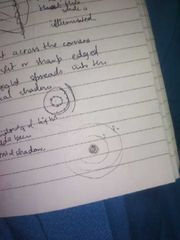
The speed with which the wavefront moves outwards from the source. |
|
|
|
Types of wavefronts generated depends on the |
Source of disturbance |
|
|
|
Types |
Spherical Cylinderical Plane |
|
|
|
Ray |
The energy of a wave travels in a direction perpendicular to the wavefront Ray is an arrow drawn perp to a wavefront in the direction of propagation of wave. It represents the path along which the wave travels. |
|
|
|
A collection of rays of light is called |
A beam of light |
|
|
|
Cylinderical wavefront |
When the source of light is linear in shape(like a fine rectangular slit), the wave front generated is cylinderical in shape. |
|
|
|
Spherical wavefront |
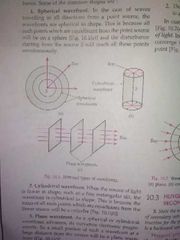
When the source of light is a point src, the wave front generated is spherical in shape Diagram |
|
|
|
Plane wavefront |
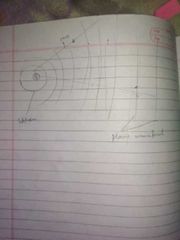
As a spherical/cylinderical wavefront progresses, its curvature decreases progressively. So, a small portion of such a wavefront at a large distance from the source will appear to be a plane wave front |
|
|
|
Huygen's princilple |
Each point on a wave front is a source of secondary waves(spherical), which add up to give a wavefront at any later time. |
|
|
|
Polarisation of wave |
The phenomenon of restricting vibrations of a transverse wave to just one direction in a plane(plane of vibration) perpendicular to the direction of propagation. |
|
|
|
Unpolarized wave(light) |
When the vibrations in a transverse wave are in all possible directions in a plane perpendicular to the direction of propagation, the wave is said to be unpolarized. |
|
|
|
Law of Malus |
I=I⁰cos²∅ where theta is the angle between the planes of transmission of the polariser and the analyser. Where I is the intensity of the light transmitted by the analyser and Io is the maximum intensity transmitted by the analyser i.e. when the planes of transmission of polariser and analyser are parallel to each other (i.e when ∅=0⁰) |
|
|
|
Brewster's law |
U(refractive index of the transparent medium)=tan i(p) Where I(p) is the angle of polarisation/Brewster's angle When ordinary unpolarized light is incident on a transparent medium, the reflected ray is found to be partially plane polarised. The extent of polarisation depends on the angle of incidence. At a particular angle of incidence, the reflected ray is found to be completely polarised. That angle of incidence is called angle of polarisation/Brewster's angle. |
|
|
|
Relationship between path difference and phase difference∅ |
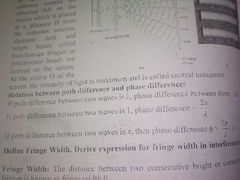
|
|

